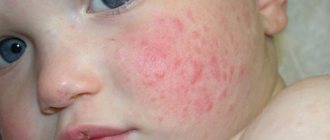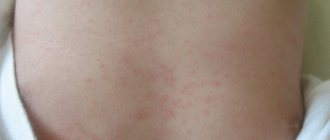Reason for allergic reaction
With a detailed study of the problem of the occurrence of an allergic reaction, it becomes clear that it is not thick fur that is the cause of intolerance, but rather the secretions that the animal’s body produces. If parents discover that their child is allergic to a pet, they should understand that this is a reaction to secreted proteins. It is they who cause an acute reaction in a small organism.
Animal proteins get into the air, which is why, even if a child gets into the same room where there is an animal, he can get sick.
The greatest danger for children with allergies is cat secretions. Proteins secreted by representatives of the cat family are presented in microscopic sizes. They easily rise in the air flow and can easily penetrate the mucous layers in the nose.
Very often, allergies in children occur to dogs. In addition to the fact that dogs are more likely than others to provoke the development of an allergic reaction, they act as allergens with which children are constantly in contact.
Despite the fact that most often cats and dogs are the aggressors of animal allergies in children, there are several animals that can also provoke an exacerbation of the disease. It is extremely rare that skin blooms can occur from reptiles.
Allergy to dogs: treatment and diagnosis
There are many substances that can cause an allergic reaction. Therefore, before getting rid of your dog or minimizing contact with it, you need to find out whether your pet is causing the allergy or whether the problem is something else.
To do this, after the first symptoms of an allergy appear, you need to consult a doctor. Make an appointment with an allergist, dermatologist and immunologist. After an external examination, the doctor will perform special tests to confirm epidermal sensitization. They may be as follows:
- Skin tests. These include prick tests or light prick tests. To do this, a drop of an allergen substance is applied to the forearm. The skin under the drop is then lightly scratched or pricked to allow the substance to enter the body, after which the reaction is assessed. If a papule is formed from 2-3 to 10 mm, the result is considered positive.
- Immunoglobulin analysis. For such a study, venous blood is taken from the patient for analysis and mixed in a test tube with the allergen.
- Provocative tests. This type of examination is carried out only in a hospital setting and is used quite rarely. To find out whether a patient has an allergy, he has to inhale a small amount of an allergen substance, while the doctor records the body's reaction to the provocation.
- When choosing a pet, allergy sufferers should immediately exclude “drooling” breeds with flat cheeks and drooping jowls: English and Great Danes, bulldogs, Neapolitan mastiffs, St. Bernards, boxers, bullmastiffs, Shar-Peis, Fila Brazelieros and others.
- Focus on the size of the dog. Of course, the smaller the animal, the fewer allergens it will emit.
- It is recommended to choose silent breeds, as they bark less often and therefore spread less saliva around them.
- Some dogs that have fairly long coats may become less allergenic than their smooth-coated counterparts. Wool itself cannot be called a full-fledged allergen, but it acts as a transporter: when wool falls out, it spreads allergen proteins from the skin throughout the house.
- There are dog breeds that practically do not shed: dead hairs fall out only during combing or trimming (plucking). These include Bolognese, Puli, Shih Tzu, Yorkshire Terrier: despite their long hair, these breeds practically do not shed.
Once the diagnosis is established, the doctor draws up a treatment plan. The volume of therapy depends on the “localization” of allergic inflammation and the severity of clinical manifestations.
Allergy-free dogs: myth or reality?
One common misconception is that if you get a short-haired or hairless dog, you can avoid allergies. In practice, everything turns out differently: it is not wool, but microscopic particles of allergen proteins produced by the animal’s body that cause atypical reactions of the hosts’ immune system. Therefore, the appearance of even hairless Chinese crested or Peruvian Inca orchids in the house can become a trigger for the development of allergies to dogs.
However, some dogs are still less likely to cause allergies in children and adults than their other relatives. How to make the right choice?
Symptoms to determine allergies
Allergies to animals in children have immediate symptoms. This is due to the fact that in this case the allergen penetrates through the mucous membrane directly into the nasal cavity or eyes. The tissues of the nose and eyes have a high rate of absorption of foreign proteins. In addition, they are endowed with a large number of cells responsible for immunity, when inflamed, an allergic reaction occurs.
Most often, the first signs of an allergy to animals in a child appear a few minutes after entering the area where the allergen is located. The substance that causes the rejection reaction enters in several ways:
- ingestion of the allergen along with inhaled air masses;
- upon contact with animal fur (important - the fur itself cannot cause an allergy, only the saliva with which the animal cleans itself);
- with physical (direct) contact, this happens when an animal licks a child.
In this case, you need to be extremely careful, since an allergy to animals manifests itself as a disorder of the respiratory system. It is she who reacts more acutely to the effects of animal protein.
Signs of allergies
To provide urgent medical care, you should know the main signs that a child is suffering from an allergic reaction to animals (this will allow you to avoid complications in the future and begin treatment with medications on time):
- The nasal mucosa is damaged
. This phenomenon is typical when swelling appears in the nasopharyngeal mucosa. This happens in the following way: the capillaries expand under the influence of the allergen and cause nasal congestion. It becomes difficult for the patient to breathe and he begins to choke. A period of severe runny nose sets in, which is accompanied by severe sneezing. - A cough begins
. This phenomenon is typical in cases where the allergen enters the larynx and trachea. The presence of a cough allows you to remove foreign bodies from the body. As a rule, an allergy cough is dry. The main sign of the presence of edema in the larynx is a whistling echo that accompanies coughing attacks; this occurs due to the retention of air escaping through the surface of the edema. - Hoarseness in the voice
. In cases where the vocal cords are sensitive to the allergen, hoarse sounds appear in the voice of the allergic person. - Redness of the eyes
. Dilatation of blood vessels in the eyes under the influence of an allergen leads to intense redness. There is tearing and swelling of the upper eyelid. - The heart rate increases
. When an allergen enters the child’s body, antibodies begin to be produced that are designed to fight the aggressor - they lower blood pressure, and the heart begins to contract more intensely.
In addition to the unpleasant consequences described, a child who is allergic to animals is likely to develop bronchial asthma. As a rule, these are consequences of neglect of the initial symptoms of an allergic reaction. That is why, if signs of an allergy to the presence of animals are detected, it is necessary to undergo a diagnosis of the body in order to begin treatment on time.
Prevention
It is better to try to prevent any disease. Therefore, if you want to avoid any allergic manifestations in your child, you need to follow these rules:
- introduce complementary foods after consultation with a specialist. Many mothers want to quickly “pamper” their baby with delicious food, without thinking about how the child’s body will react;
- dress your child according to the weather. It has long been proven that overheating is much worse than hypothermia;
- a nursing mother should try the products and carefully monitor the baby’s reaction;
- when choosing infant formula, strictly follow the pediatrician’s instructions;
- maintain an optimal microclimate in the children's room (with a temperature no higher than 20-22 C and a humidity of 60-70%) and carry out wet cleaning as often as possible;
- wash children's clothes with special powders and carefully select cosmetic care products.
These simple recommendations will significantly reduce the risk of developing allergies in children and will become the best helpers in the fight against existing diseases!
Take care of your health!
Diagnosis methods
When examining the nasal cavity, the doctor may ask several questions, based on which they will assume that the child has an allergy to animals. A light instrument is used to examine the condition of the nose lining. If your child is allergic to pets, the lining of the nasal passage will be swollen, pale, or bluish.
Allergy skin test
Your doctor may suggest an allergy test to pinpoint the cause of your allergy. Such tests are carried out by allergists. The test method consists of applying solutions with allergens of certain animals to the skin of an allergic person in order to find out what type of rejection reaction is manifested.
This method is not suitable for children whose symptoms of the disease are at the progression stage. This method can worsen unpleasant allergy symptoms. The main location for testing is the legs or forearm area.
Blood sampling to determine allergies
The most reliable way to find out about the presence of an allergic reaction is to draw blood from a vein, which will accurately show the level of antibodies in the body. An increased level of antibodies indicates the body's fight against the allergen. Blood tests are carried out in special laboratory centers to understand the causes of the disease.
How to diagnose allergies?
Allergies occur when a person’s immune system reacts to environmental substances that are harmless to most people. These substances are known as allergens. They are found in dust, pet dander, pollen, insects, mites, mold, food and some medications.
What happens during an allergic reaction?
When a person who is allergic to a particular allergen comes into contact with it, an allergic reaction occurs. If an allergen, for example pollen, enters the body for the first time, it stimulates the production of antibodies and the formation of sensitized lymphocytes. When the pollen allergen comes into contact with antibodies again, antigen-antibody complexes are formed. The complexes are fixed on the surface of mast cells, causing their degranulation. As a result, histamine and other inflammatory mediators are released. Since mast cells are ubiquitous, an allergic reaction can occur in any organ. In humans, small vessels and bronchi are more often affected, so the clinical manifestations of their damage appear first.
Allergies come in a variety of forms: respiratory tract allergies (allergic rhinitis and bronchial asthma), allergic conjunctivitis, allergic dermatitis, allergic enteropathy and the most severe and life-threatening condition - anaphylactic shock.
Depending on the form, symptoms vary widely.
The most typical symptoms of allergic reactions are:
- spontaneous runny nose;
- frequent sneezing;
- tearfulness;
- rash;
- itching;
- vomit;
- diarrhea;
- redness;
- edema;
- temperature increase.
Allergic reactions occur within 30 minutes after contact with the allergen.
The correct diagnosis can be made based on medical history and symptoms, and can be confirmed by a special allergy test.
Seeking medical help is especially important for children, since a single primary allergy can quickly develop into multiple allergies, and allergic rhinitis can cause asthma. Early diagnosis is justified because it allows for preventive treatment, minimizing the impact of allergies in the future.
History taking
Special attention is paid to collecting anamnesis. The presence of allergy symptoms, especially when identifying associations with triggers described by the patient himself, speaks in favor of an allergic component.
Allergies often appear after eating certain foods, inhaling pollen, contact with animals, insect bites, taking certain medications, etc.
In patients with contact dermatitis or skin allergies, a history of exposure to latex, metals, fabric fibers, detergents, etc. is significant.
When a food allergy is identified, the patient is recommended to keep a food diary, which allows a more targeted understanding of which product is the trigger of the allergic reaction.
List of questions asked by an allergist during an appointment:
- What is the time of onset of the reaction after ingestion of the suspected food?
- Is there a consistent association of symptoms with certain foods?
- How much of a potentially allergenic food triggers symptoms?
- Does anyone else in the family who consumed the food exhibit similar symptoms?
Family history of allergies
When collecting anamnestic data, the doctor is always interested in whether any of the family members have had or are suffering from allergies. Finding first-degree relatives, such as parents and siblings, who suffer from allergies is important in diagnosing atopic conditions.
Atopy
- This is a genetic (hereditary) tendency for the development of allergic diseases. People with atopy are said to be atopic.
The tendency to atopy is determined by both genes and environmental factors.
Allergy tests
Skin tests (allergy tests) and blood tests help determine whether a person actually has an allergy.
Skin tests confirm the allergic nature of the disease. They are performed in the office of an allergist and allow you to quickly get an answer. Skin testing “provokes” an allergic reaction by introducing a small amount of an allergen—a substance that doctors believe you may be allergic to. If you have an allergy, your skin will react and something similar to a mosquito bite will appear where the allergen is applied.
There are three main types of skin tests: patch tests, prick tests and skin prick tests.
1).
Patch tests. When testing using patches, the doctor sticks test strips impregnated with the allergen.
The patient must undergo them for about 2 days, after which the doctor will evaluate the results at a follow-up appointment. This testing is used to diagnose contact allergies. 2).
Scarification tests. It involves applying the allergen to scratches, which the doctor makes with a lancet or needle.
Scratches occur on the forearm or upper back. If a reaction occurs at the site of damage to the skin - redness, scratching, etc., then this is a sure sign of an allergy. This method is the most popular in our country. 3).
Prick tests. The method is similar to the previous one, only instead of scratching the skin is pierced with a thin needle. The method is easier to tolerate, but less common in our country.
When preparing for skin testing, it is important to stop taking antihistamines two weeks in advance; 7 days before their placement, stop using antiallergic ointments.
Standard contraindications to skin allergy testing are:
- exacerbation of chronic diseases;
- the presence of diseases in the acute stage;
- exacerbation of allergies.
It is advisable to perform skin tests only when the child reaches 5 years of age. If there are clear indications, then you can resort to them earlier, starting from 2 years of age.
Blood test for IgE
In the blood, the total level of IgE and the presence of specific immunoglobulins can be determined. The total level of immunoglobulin E (IgE) in the blood indicates a tendency to allergies.
A blood test for specific IgE is used to confirm the results of skin tests. Immunoglobulin E (IgE) antibodies are substances produced by the body during an allergic reaction to a specific allergen. If high levels of specific IgE are detected in the blood, and there is a corresponding history, then these data together help confirm the allergic nature of the disease. However, an elevated result does not always indicate an allergic component. The laboratory test result should support clinical findings and skin testing in favor of an allergy. A negative result of laboratory testing for IgE, on the contrary, in 90% indicates the absence of pathology.
Treatment options
The first stage of treatment for allergies to pets involves avoiding contact with them. It is impossible to completely eliminate contact with the allergen. Even after removing a pet from the home, there is always a chance that a child will come into contact with them on the street or through exposure to dust particles on other people's clothing.
But in order to quickly relieve the symptoms of the disease, it is not enough to simply exclude contact. It is necessary to begin treatment with medications. It is better to treat infants under one year of age under the strict supervision of specialists.
Allergy medications
Your doctor will prescribe one of the following medications to relieve nasal allergy symptoms:
- Antihistamines reduce the production of an immune system chemical that is heavily involved in an allergic reaction, and they help relieve itching, sneezing, and a runny nose. Antihistamines prescribed as a nasal spray include azelastine (Astelin, Astepro) and olopadatine (Patanaz). Over-the-counter (antiretroviral) antihistamine tablets include fexofenadine, loratadine (Claritin, Alavert), and cetirizine (Zyrtec Allergy). These medications are well suited for treating children;
- Corticosteroids prescribed as a nasal spray can reduce inflammation and control hay fever symptoms. These drugs include mometasone furoate (Nasonex), triamcinolone (Nasacort Allergy 24-Hour), and ciclesonide (Omnaris). Nasal corticosteroids require low doses of the drug and have a much lower risk of side effects than oral corticosteroids;
- Decongestants help tighten swollen tissue in the nasal passages and make breathing through the nose easier. Some allergy pills combine an antihistamine with a decongestant; Leukotriene modifiers block the action of certain immune system chemicals.
Other treatments
Immunotherapy. You can always “train” the immune system of a young body so that it does not show sensitivity to the allergen. The technique of using this method involves intentional contact with the allergen several times, until the child’s body fully adapts.
Nasal irrigation. Rinse with sea salt solution. If parents prepare saline solution themselves, it is necessary to use water that does not contain contaminants - distilled, sterile, pre-boiled and cooled. Or passed through a filter that has the smallest size.
Prevention measures and later life
A negative reaction of a child’s body to the presence of a pet may appear after short remissions. To avoid this, it is best to remove the animal from the house, but there are cases when the owners are very attached to their pet.
What to do to leave your pet at home
The first rule is to close the doors to the nursery, where the child spends most of his time. Another good method would be to use an air purifier and constantly clean the room.
Please remember that animal fur is very sticky. If the decision to leave your pet at home has been made, it is best to completely clean the room and throw out old furniture and carpeting.
Washing your pet every week will reduce the presence of allergens in the air, but is of questionable value in reducing the child's symptoms.
It is necessary to clean the pet of dandruff (skin particles), and also clean its oral cavity, removing all rot from the teeth.
Before deciding to follow such complex preventive measures to leave the animal at home, you need to know that there are pets that do not cause allergies in children.
Treatment
Of course, you need to go to a doctor for a treatment program. Typically, treatment consists of prescribing antihistamines that block the development of processes leading to the occurrence of allergies. These are drugs such as Telfast, Tavegil, Loratadine, Aleron, Fenistil, Zyrtec, and many others.
To treat symptoms in children, third-generation drugs are used that do not cause side effects, in particular drowsiness. But once again we draw attention to the fact that only a doctor should prescribe drugs, especially to children. He will determine the dosage, regimen and tell you how to proceed.
Which animals do not produce allergens?
There are animals that will be safe even for a child suffering from chronic allergies. These include:
- chinchillas;
- turtles;
- fish;
- chameleons;
- lizards;
- Syrian breed of hamsters;
- cats with minimal hair;
- dogs with limited fur coverage.
Every child dreams of having a pet to take care of. But not everyone can afford it due to a certain reaction of the body. Before bringing a kitten or puppy into the home, parents should make sure that their child does not suffer from an allergy to animal protein. And if allergen tests are positive, then it would be better to give the child a hypoallergenic animal.
Causes
An allergy is, essentially, the body's reaction to a specific substance, which may be completely harmless to the immune system. But with repeated exposure to the allergen, the body’s sensitivity increases and certain symptoms known to medicine occur. Allergens are different: household, medicinal, food, infectious, contact. Why is it that some people are allergic to dogs and others are not?
Causes:
- Heredity plays a very important role. If one of the parents suffers from a similar allergy, then in 70-80% of cases the child will also get sick;
- with a weakened immune system, there is a risk of disease;
- There is another reason why allergies can occur - hypersensitivity. Your child may have been born with increased individual sensitivity to an allergen.









